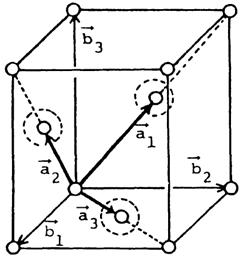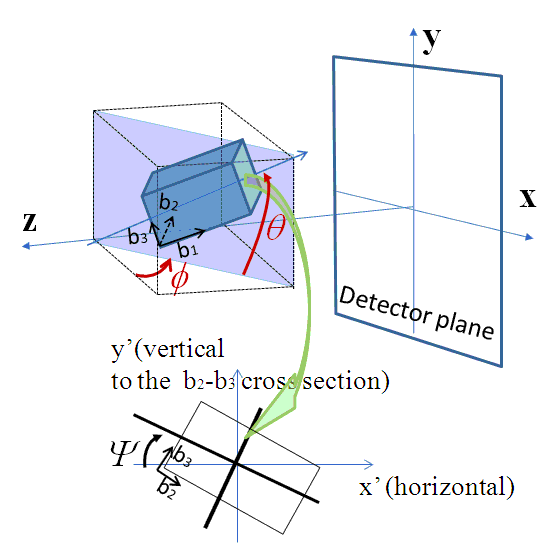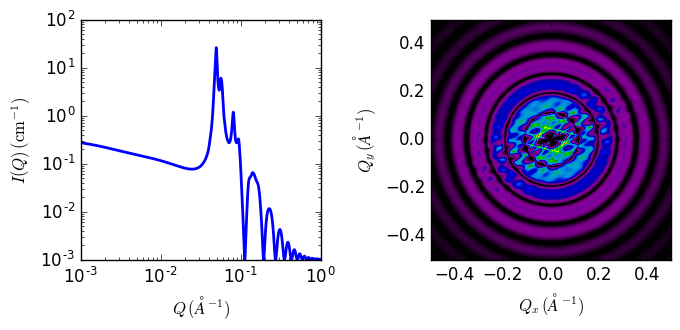fcc_paracrystal
Face-centred cubic lattic with paracrystalline distortion
| Parameter | Description | Units | Default value |
|---|---|---|---|
| scale | Source intensity | None | 1 |
| background | Source background | cm-1 | 0.001 |
| dnn | Nearest neighbour distance | Å | 220 |
| d_factor | Paracrystal distortion factor | None | 0.06 |
| radius | Particle radius | Å | 40 |
| sld | Particle scattering length density | 10-6Å-2 | 4 |
| sld_solvent | Solvent scattering length density | 10-6Å-2 | 1 |
| theta | In plane angle | degree | 60 |
| phi | Out of plane angle | degree | 60 |
| psi | Out of plane angle | degree | 60 |
The returned value is scaled to units of cm-1 sr-1, absolute scale.
Calculates the scattering from a face-centered cubic lattice with paracrystalline distortion. Thermal vibrations are considered to be negligible, and the size of the paracrystal is infinitely large. Paracrystalline distortion is assumed to be isotropic and characterized by a Gaussian distribution.
Definition
The scattering intensity \(I(q)\) is calculated as
where scale is the volume fraction of spheres, \(V_p\) is the volume of the primary particle, \(V_\text{lattice}\) is a volume correction for the crystal structure, \(P(q)\) is the form factor of the sphere (normalized), and \(Z(q)\) is the paracrystalline structure factor for a face-centered cubic structure.
Equation (1) of the 1990 reference is used to calculate \(Z(q)\), using equations (23)-(25) from the 1987 paper for \(Z1\), \(Z2\), and \(Z3\).
The lattice correction (the occupied volume of the lattice) for a face-centered cubic structure of particles of radius \(R\) and nearest neighbor separation \(D\) is
The distortion factor (one standard deviation) of the paracrystal is included in the calculation of \(Z(q)\)
where \(g\) is a fractional distortion based on the nearest neighbor distance.

Fig. 48 Face-centered cubic lattice.
For a crystal, diffraction peaks appear at reduced q-values given by
where for a face-centered cubic lattice \(h, k , l\) all odd or all even are allowed and reflections where \(h, k, l\) are mixed odd/even are forbidden. Thus the peak positions correspond to (just the first 5)
NB: The calculation of \(Z(q)\) is a double numerical integral that must be carried out with a high density of points to properly capture the sharp peaks of the paracrystalline scattering. So be warned that the calculation is SLOW. Go get some coffee. Fitting of any experimental data must be resolution smeared for any meaningful fit. This makes a triple integral. Very, very slow. Go get lunch!
The 2D (Anisotropic model) is based on the reference below where \(I(q)\) is approximated for 1d scattering. Thus the scattering pattern for 2D may not be accurate. Note that we are not responsible for any incorrectness of the 2D model computation.

Fig. 49 Orientation of the crystal with respect to the scattering plane.

Fig. 50 1D and 2D plots corresponding to the default parameters of the model.
References
Hideki Matsuoka et. al. Physical Review B, 36 (1987) 1754-1765 (Original Paper)
Hideki Matsuoka et. al. Physical Review B, 41 (1990) 3854 -3856 (Corrections to FCC and BCC lattice structure calculation)